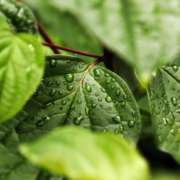Catching and Storing Rainwater for Your Landscape
During the rainy fall and winter seasons in Southern California, catching and storing rainwater is beneficial for cutting down on irrigation costs. It can also be stored for later use through the rest of the year.
Know the path rainwater will take
If there are rain gutters on your house, water will flow into downspouts, where it can move with great force and speed. This is especially true in a large storm. Instead of allowing downspouts to discharge directly on hard surfaces like a driveway, path, or patio, plan ways to redirect downspout water into vegetated landscape areas. This will be a more efficient use of the natural irrigation.
Replacing downspouts with “rain chains” to slow down the water is one option. This way, water can be more easily absorbed when it reaches your landscape. Add a rain barrel or cistern at the bottom of downspouts or rain chains and let it overflow into your garden.
If your house does not have rain gutters, water shears off roof surfaces and can cause erosion damage. Cover areas under the eaves in permeable ground covers such as pea gravel, mulch, or rocks. Ground covers can reduce the compacting force of water falling on bare soil. Spread fresh leaf and wood chip mulch throughout the garden to slow down water. Healthy soil can withstand even the strongest rain. Once the rainwater is absorbed into the soil, your plants’ roots will grow deeper. This will help them thrive throughout the year.
Ways to store rainfall
Rainwater can also be harvested and stored. Rain barrels and cisterns directly connected to downspouts are great storage containers. Check out your local water district or water agency to see if there are any rebates or incentives available.
Stored water can be released gradually into the landscaping between winter rainstorms. This will help build up the soil sponge and ensure that native plants get adequate water when they need it most. If you need water in the summer and capture enough of it during the winter, you may be able to use your stored water for irrigation.
Both rain barrels and above–ground cisterns can be relatively inexpensive to purchase and easy to install. Use screens to keep mosquitos out. With minimum maintenance and common sense, you can keep the water safe and clean. If you plan to store rainwater, make sure the “first flush” is diverted directly into the landscaping before capturing the rainfall that follows. This is important because the “first flush” will collect debris and contaminants that have built up on surfaces throughout the dry months.
Use your landscape to capture rain
You can design your landscape to effectively collect water. Properly placed trees are excellent landscaping features to help capture rainfall, allowing it to be released slowly over time into the soil. Taller, stronger plants placed strategically can also allow you to control the flow of water.
With a little planning, you can capture and store rainwater easily and effectively during the rainy season and use it throughout the year.
The San Diego County Water Authority, its member agencies and partners offer other water-saving resources including free WaterSmart classes at WaterSmartSD.org.



